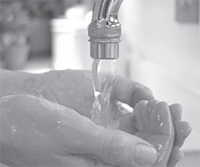Breast Milk Collection & Storage

Guidelines for Healthy Newborns
Many mothers find it convenient to collect their breast milk and store it for use at a later time. Such is the case for mothers who return to work, school or who are separated from their infant. The guidelines offered below may answer some questions you may have about safely storing breast milk for your full-term newborn. If you have a preterm newborn, please see your healthcare professional for the guidelines to properly and safely store and transport your breast milk.
Collecting Breast Milk

- Wash hands well with soap and water.
- Wash all the collection bottles and breastpump parts that touch your breasts or the milk with hot, soapy water or in a dishwasher. Rinse with cold water. Air dry on a clean towel. When soap and water are not available use Medela Quick Clean™ wipes. If your baby is premature or ill, the hospital may ask you to sanitize your pump parts.
- Read the instruction book that comes with your pump for proper collection procedures. Sanitize your pump parts once a day as described.
- Practice pumping when you are rested, relaxed and your breasts feel full. You may try to nurse your baby on only one side and pump the other breast. Or pump for a few minutes if your baby skips a feeding or nurses for only a short while. Pumping should not hurt. Your nipple should fit comfortably in the breastshield.
- Medela makes different sizes of PersonalFit™ breastshields to fit all nipple sizes, from small to extra large. If you are having problems finding the right size breastshield or have questions on proper fit, ask for help from a lactation consultant or healthcare provider.
- You can help your baby learn to take a bottle once breastfeeding is established and going well. It is best to wait for three (3) to four (4) weeks before introducing bottles. If you are having problems breastfeeding, ask for help from a lactation consultant or healthcare provider.
- Begin to pump and store milk one (1) or two (2) weeks before returning to work. Many working mothers use the fresh milk they pump at work for feedings the next day. Freeze your extra milk for emergencies.
- Ideally, pump every three (3) hours when you are away from your baby. Ten minutes of pumping during breaks and 15 minutes of pumping during lunch with a good pump will help protect your milk supply. If you can’t pump three (3) times, pump as much as you can during each day.
- Breastfeed in the evening and on days off to help maintain your milk supply and protect your special bond with your baby.
Storing breast milk
- It is normal for pumped milk to vary in color and consistency depending on your diet. Stored milk will separate into layers and the cream will rise to the top. Gently swirl (don’t shake) the bottle to mix the milk layers.
- Avoid adding freshly pumped milk to already cooled milk. You can add small amounts of cooled breast milk to the same refrigerated container throughout the day.
- Pumped milk may be added to frozen milk provided it is first chilled and the quantity is less than what is frozen.
- Store your milk in Medela’s BPA-free breast milk collection bottles or in storage bags specifically designed for breast milk, such as Medela’s BPA-free Pump & Save bags.
- Freeze milk in two (2) to four (4) ounce portions. Small amounts thaw more quickly. You will waste less milk this way. Be sure to leave some extra room at the top of the container so the bottle or bag will not overflow when freezing or thawing.
- Seal containers tightly. Write the date on a piece of tape and place on the bag or bottle. Use the oldest milk first.
- Rarely, some mothers notice their defrosted breast milk has a soapy taste or odor. This is due to lipase, an enzyme, which helps to digest the fat content of the breast milk. If this occurs, scald the breast milk (do not bring to a boil) on a stove until tiny bubbles appear along the sides of the pan; do this before freezing. The scalding process will neutralize the enzyme, preventing the soapy taste or smell.
- If you do not plan to use the milk within a few days, freeze it right away in the coldest section of your freezer.
Defrosting

- Thaw milk overnight in the refrigerator, or hold the bottle under warm running water until thawed. You can also place the sealed container in a bowl of warm water for 20 minutes to bring it to body temperature. Do not let the water reach the level of the container cap.
- Thawed milk is safe in the refrigerator for up to 24 hours.
Caution: Never microwave breast milk. Microwaving can cause severe burns to baby’s mouth from hot spots that develop in the milk during microwaving. Microwaving can also change the composition of breast milk.
Your Milk Supply and Your Baby’s Needs
- In the past it was thought that mothers needed to make more and more milk as their babies grew. Scientists now know that a healthy milk supply remains fairly constant over the six (6) months of exclusive breastfeeding. Your baby will take the amount he needs.
- During the early weeks, babies eat very frequently and grow very quickly. By day 10-14, babies should regain any weight they lost after birth. For the next few months babies will gain about an 1/2 ounce to 1 ounce a day.
- Around three (3) to four (4) months, a breastfed baby’s rate of growth begins to slow down. Your milk supply will continue to satisfy the baby until it is time to introduce solids at 6 months.
- By the end of the first week of life, women who are breastfeeding one baby normally make between 19 to 30 ounces of milk each day. Infants between one (1) and six (6) months of age normally drink an average of 19 to 30 ounces a day.
- An average size “meal” for a baby is between three (3) to five (5) ounces of breast milk. Formula is harder to digest and less well absorbed. Formula fed babies may need larger feeds. Consult your healthcare professional for advice.
Resources
Go to Medela for products and information available for you and your baby.
To locate Medela products or a breastfeeding specialist in your area, go to Medela or call 1-(800) TELL YOU, 24 hours a day, 7 days a week.
Some other excellent resources:
- International Lactation Consultant Association
- La Leche League International
- United States Lactation Consultant Association
Medela, Inc.,
P.O. Box 660
1101 Corporate Drive
McHenry, IL, 60051-0660
Medela Canada, Inc.,
4160 Sladeview, Crescent Unit #8
Mississauga, ON L5L OA1
Phone: (800) 435-8316 or (815) 363-1166
Fax: (815) 363-1246
Contact Medela by email
Medela